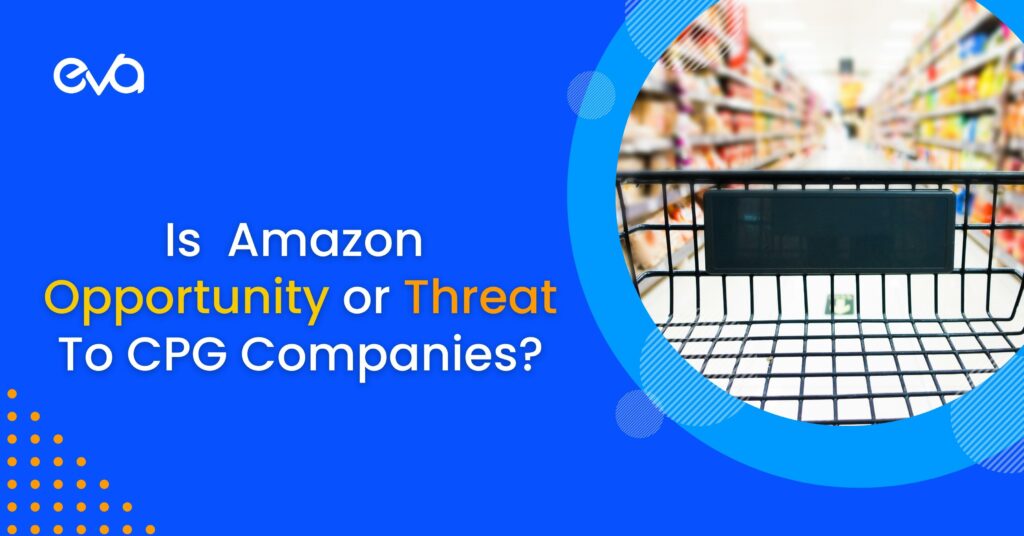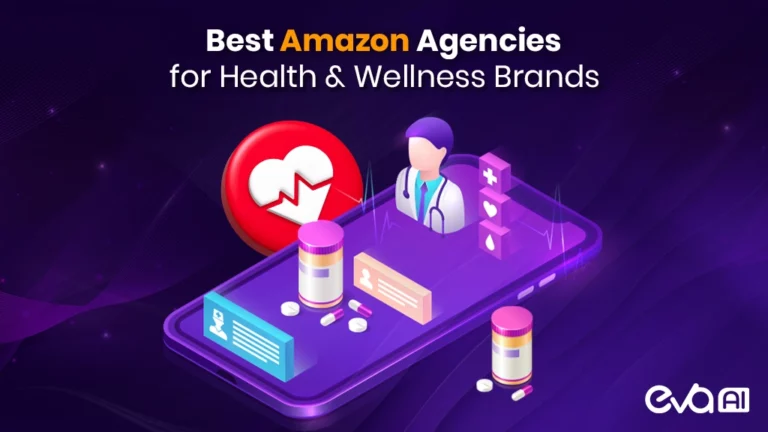As Amazon grows in popularity, it’s no surprise that CPG companies are taking notice. But should these brands see the Amazon marketplace as an opportunity or a threat? This is a hotly debated question within the industry, and the answer isn’t always clear. This blog post will take a look at both sides of the argument and help you decide what’s best for your CPG brand.
Table of Contents
- Amazon’s Effect on CPG Companies
- Amazon Is a Threat to CPG Companies Because …
- Amazon Is an Opportunity for CPG Companies Because …
- The Pros and Cons of Amazon For CPG Companies
- The Key to Success for CPG Companies
- Frequently Asked Questions (FAQs)
- How Can Eva Help CPG Companies with Selling on Amazon?
- Conclusion
Amazon’s Effect on CPG Companies
As the biggest market in human history, Amazon affects any brand that enters the marketplace in various good and bad ways. Here we have listed 4 major impacts of Amazon on CPG (Consumer Packaged Goods) companies:
1. Increased Competition
The entry of Amazon into the CPG space has increased competition for traditional brands. Amazon has used its vast resources to aggressively price its own private label products, which are often cheaper than similar products from established brands. In addition, Amazon has also invested heavily in marketing and promotion, making it difficult for traditional brands to keep up.
2. Changed Consumer Behavior
Amazon has also changed consumer behavior when it comes to shopping for CPG products. Thanks to Amazon Prime and other convenience-oriented features, consumers can now get their CPG products delivered to their doorsteps with just a few clicks. This has made it easier for consumers to compare shops and find the best deals on the products they need.
3. New Data and Insights
Another effect of Amazon’s entry into the CPG space is that brands now have access to a wealth of data and insights that they didn’t have before. Amazon tracks everything from what products are being searched for to what products are being purchased and everything in between. This data can be extremely valuable for brands as they look to understand consumer behavior better and make more data-driven decisions about product development, marketing, and pricing.
4. Increased Pressure on Margins
Finally, Amazon’s entry into the CPG space has put pressure on margins for traditional brands. Amazon is known for its fast delivery combined with low prices, and its private-label products are often even cheaper than similar products from established brands. This puts pressure on traditional brands to either lower their prices or find ways to improve their margins through cost savings or other means.
Read More: Should CPG Startups Sell on Amazon?
Amazon Is a Threat to CPG Companies Because …
CPG companies are used to having things their way. For years, they’ve held a dominant position in the marketplace with little to no competition. But that all changed when Amazon decided to enter the CPG space. With its aggressive pricing and Prime shipping, Amazon quickly began taking market share away from CPG companies. And because CPG companies are not used to competition, they struggle to adapt. They’re still trying to figure out how to compete with Amazon, and in the meantime, their market share is suffering. So while CPG companies may have once been the top dogs, they now have a real fight on their hands.
Amazon Is an Opportunity for CPG Companies Because …
Amazon is a big opportunity for CPG companies because it provides them with a new way to reach consumers. More and more people are shopping on Amazon, which means more potential customers for CPG companies.
Amazon also provides CPG companies with a way to reach customers who might not be able to find their products in traditional stores. Amazon has a huge number of products, and it’s constantly expanding. That means that there’s always room for new products and new companies. CPG companies should definitely take advantage of Amazon’s reach.
The Pros and Cons of Amazon For CPG Companies
1. Pro: Amazon Is the World’s Largest eCommerce Platform
There’s no denying that Amazon is the biggest player in the eCommerce space. In 2018, they accounted for nearly 50% of all online sales in the US. And that number is only expected to grow in the coming years. So, selling on Amazon is a no-brainer if you’re looking to reach the widest possible audience with your CPG products.
2. Con: You’ll Be Competing with Millions of Other Amazon Sellers
Of course, the downside to Amazon’s massive size is that you’ll be competing with millions of other third-party sellers for attention. So you should make sure your products are well-priced and well-marketed if you want to stand out from the crowd.
3. Pro: Amazon Prime Customers Are Loyal and Spend More
Amazon Prime customers are notoriously loyal to the platform. In fact, a recent study found that Prime members are willing to spend an average of $1,300 per year on Amazon, compared to just $700 for non-Prime members. So, if you can get your products in front of Amazon Prime customers, you will likely see a sales bump.
4. Con: You’ll Need to Meet Amazon’s Strict Guidelines
To sell on Amazon, you’ll need to meet their strict guidelines and requirements. This can be anything from having high-quality product photos to offering competitive prices. If you don’t meet their standards, your products could be removed from the site entirely.
5. Pro: You Can Use Amazon FBA to Fulfill Orders
If you don’t have the resources to fulfill orders yourself, you can take advantage of Amazon Fulfillment by Amazon (FBA). This service allows Amazon to store, pick, pack, and ship your products for you. And best of all, it’s included in your monthly seller fees!
Grow your business on Amazon with Subscribe and Save – learn how to take advantage of this powerful tool.
The Key to Success for CPG Companies
1. Find a Balance between Amazon and Other Sales Channels
CPG companies have long relied on brick-and-mortar stores to reach their customers. However, with the rise of eCommerce, that is no longer the only option. CPG companies now have to decide whether to invest in their own eCommerce platforms or rely on Amazon. Each option has its advantages and disadvantages.
CPG companies that invest in their own eCommerce platforms have more control over the customer experience. They can also collect customer data and use it to improve their marketing and product development efforts. However, building and maintaining an eCommerce platform is a significant investment, and it can be difficult to compete with Amazon’s scale and reach.
CPG companies that choose to sell on Amazon also have to deal with competition from other sellers, and they may not be able to control the customer experience as much as they would like. However, Amazon is a proven platform with a large customer base, and it can be a less expensive option than building an eCommerce platform from scratch. CPG companies must find the right balance between investing in Amazon and their own eCommerce platforms. Depending on their goals and resources, one option may be more advantageous than the other.
2. Do NOT Overspend on Amazon
CPG companies have long relied on brick-and-mortar retailers to reach their customers. However, with the rise of eCommerce, that is no longer the only route to market. In fact, many CPG companies are now turning to Amazon as a key channel for growth.
While Amazon offers a great opportunity to reach more consumers, CPG companies must be careful not to overspend on this platform. Amazon is a very demanding partner, and CPG companies can quickly see their margins erode if they’re not careful. As such, CPG companies should focus on driving efficiencies in their Amazon strategy to protect their bottom line.
3. Create a Seamless Customer Experience
CPG companies have long recognized the importance of creating a seamless customer experience across all channels – Amazon, offline, and mobile. The goal is to provide customers with a consistent experience that is convenient and easy to use. However, this can be a challenge for CPG companies, as each channel has its own unique set of challenges.
For example, Amazon is a highly competitive eCommerce platform, and CPG companies must work hard to stand out from the crowd. On the other hand, offline channels can be more challenging to navigate due to the lack of data and the need to build relationships with brick-and-mortar retailers.
Mobile presents its own set of challenges, as customers are constantly on the go and often have limited attention spans. Despite these challenges, CPG companies must continue striving for a seamless customer experience across all channels to remain competitive.
Frequently Asked Questions (FAQs)
Amazon isn’t typically thought of as a CPG company, but they are certainly in the business of selling consumer packaged goods. In fact, they are one of the largest retailers of CPG products in the world.
How Can Eva Help CPG Companies with Selling on Amazon?
Eva combines superhuman artificial intelligence technology with top human eCommerce expertise to create an all-in-one platform for CPG brands on Amazon to meet all your needs, from pricing and Amazon advertising to 3PL logistics and returns management.
By deeply integrating pricing and supply chain management, Eva’s revolutionary platform ensures that you have maximized sales and profit without ever going out of stock or overstocked.
You are always welcome to give Eva a try with a 15-day Free Trial — the results speak for themselves!
Conclusion
The impacts of Amazon on CPG companies are significant. If you need to be prepared to compete on price and invest in marketing and promotion without overspending and ignoring other sales channels, Amazon can be a great opportunity for your CPG brand.
If you’re looking for help navigating these waters, our team at Eva can assist you with a Free Consultation. Contact us today to learn how we can help your business succeed in this ever-changing landscape.








